Neurodevelopmental disorders: definition, types, causes, symptoms, and treatments
Table of content
- What are neurodevelopmental disorders?
- What are the different types of neurodevelopmental disorders?
- What are the causes of neurodevelopmental disorder?
- What are the symptoms of neurodevelopmental disorders?
- 1. Problems with language and speech
- 2. Impaired motor skills
- 3. Abnormal behaviors
- 4. Difficulties with learning
- 5. Speech problems
- 6. Social skills deficits
- 7. Poor emotional regulation
- How is neurodevelopmental disorder diagnosed in children?
- How is neurodevelopmental disorder diagnosed in teens?
- How is neurodevelopmental disorder diagnosed in adults?
- What are the available treatments for neurodevelopmental disorders?
Neurodevelopmental disorders are conditions that impact the development and function of the brain. They range from mild to severe disorders, allowing some individuals to be high-functioning, while interfering with the daily functioning of others.
The types of neurodevelopmental disabilities include attention-deficit hyperactivity disorder (ADHD), autism spectrum disorder (ASD), cerebral palsy, communication disorders, conduct disorders, intellectual disabilities, learning disorders, and neurodevelopmental motor disorders.
While the exact cause of neurodevelopmental disorders are still poorly understood, experts speculate certain factors play a role in the development of these conditions. The causes of neurodevelopmental disorders include stress, illness, trauma, toxic chemicals in the environment, low birth weight, and fetal exposure to smoking, alcohol, recreational drugs, or medications during pregnancy.
The symptoms of neurodevelopmental disorders are problems with language and speech, impaired motor skills, abnormal behaviors, difficulties with learning, speech problems, social skills deficits, and poor emotional regulation.These disorders may not be curable, but there are a number of effective interventions that help with the management of symptoms.
The treatments available for neurodevelopmental disorders include behavioral therapy, transcranial magnetic stimulation, medication, and complementary and alternative medicine (CAM).
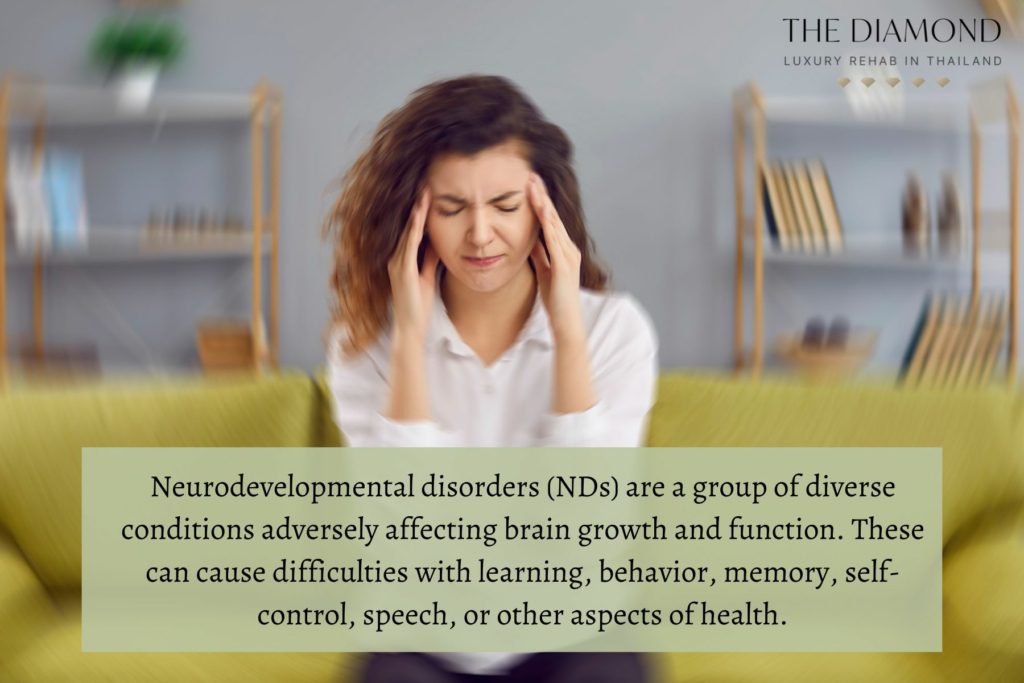
What are neurodevelopmental disorders?
Neurodevelopmental disorders (NDs) are a group of diverse conditions adversely affecting brain growth and function. These can cause difficulties with learning, behavior, memory, self-control, speech, or other aspects of health.
The symptoms of most neurodevelopmental disorders often show up during early childhood and may persist into young adulthood, or may go unnoticed or undiagnosed for years. While in some instances, a child diagnosed with a neurodevelopmental disorder may outgrow their symptoms, in most cases, they do not and the condition affects them into adulthood.
How common are neurodevelopmental disorders?
Neurodevelopmental disorders are common. In fact, a study on the current state of knowledge on the prevalence of neurodevelopmental disorders in childhood according to the Diagnostic and Statistical Manual of Mental Disorders, Fifth Edition (DSM-5) published in BioMed Central states that according to research by Petersen et al., neurodevelopmental disorders affect 15 to 20% of the child population.
On the other hand, according to the National Health Statistics Reports from the Centers for Disease Control and Prevention (CDC) during 2015 to 2018, an estimated 17.8% of U.S. children and teenagers aged 3 to 17 are impacted by NDs.
Finally, according to a research topic entitled, “Aging with Neurodevelopmental Disorders (NDD)”, published in Frontiers in Integrative Neuroscience, over the past decades, there has been an increased prevalence of NDs among middle-aged and older adults living with the condition. In the United States, for example, the number of persons aged 65 and older with autism spectrum disorder (ASD) is predicted to reach 700,000 by 2030.
What are the different types of neurodevelopmental disorders?
Different neurodevelopmental disorders commonly coexist. The different types of neurodevelopmental disorders are listed below.
- Attention-deficit/hyperactivity disorder (ADHD)
- Autism spectrum disorder (ASD)
- Cerebral palsy
- Communication disorders
- Conduct disorders
- Intellectual disabilities
- Learning disorders
- Neurodevelopmental motor disorders
- Schizophrenia
- Tourette syndrome
1. Attention-deficit/hyperactivity disorder (ADHD)
Attention-deficit/hyperactivity disorder (ADHD) is a medical condition characterized by an ongoing pattern of inattention and hyperactive-impulsive behavior. It is one of the most common neurodevelopmental disorders affecting children.
The symptoms of ADHD include difficulty focusing on a task, constantly fidgeting, problems with taking turns, excessive talking, restlessness, interrupting conversations, and acting without thinking.
The symptoms of ADHD and autism may sometimes overlap, hence it can be difficult to distinguish the two conditions, especially in younger children. While both disorders have communication difficulties as their characteristic, these difficulties may present differently in children with ADHD. For instance, someone with autism may not initiate social interactions, while an individual with ADHD talks continually and talks out of turn.
In their study published in 2020 in Scientific Reports, Pei Yin-Pan and Sven Bölte state that the physical effects associated with ADHD include unprovoked seizure, migraine, asthma, allergic rhinitis, immunological dysregulation, and atopic eczema.
The behavioral effects of ADHD include angry outbursts, defiance, meltdowns, aggressive behavior, throwing tantrums, agitation, and inattention.
2. Autism spectrum disorder (ASD)
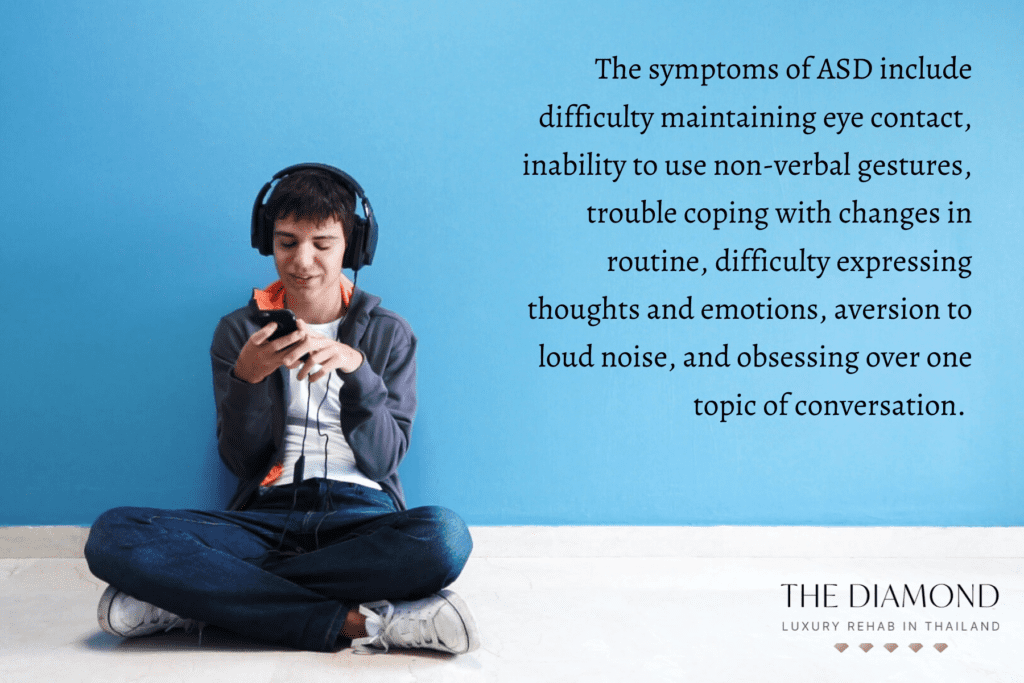
Autism spectrum disorder (ASD) is a developmental and neurological condition that involves persistent challenges with social interactions, repetitive behaviors, and limited interests.
The symptoms of ASD include difficulty maintaining eye contact, inability to use non-verbal gestures, trouble coping with changes in routine, difficulty expressing thoughts and emotions, aversion to loud noise, and obsessing over one topic of conversation.
According to an article entitled, “How Autism Differs from Other Developmental Disabilities,” from The University of Texas Permian Basin, the difference of ASD from other neurodevelopmental disorders lies in how they connect with their environment.
ASD is a “spectrum” disorder, meaning that each individual is affected differently and has a different level of ability. For instance, some kids with ASD can communicate verbally, while others express themselves nonverbally.
The physical effects of autism spectrum disorder include sleep problems, digestive issues, low muscle tone, difficulty with fine motor skills, poor coordination of balance, and abnormal gait patterns.
The behavioral effects of ASD are issues with social skills, repetitive body movements, aggression, trouble understanding how others feel, difficulty expressing how they feel, and inattentiveness to their surroundings.
3. Cerebral palsy
Cerebral palsy (CP) refers to a group of developmental disabilities that influence muscle tone, balance, movement, posture, and coordination. It occurs when the brain is unable to adequately communicate with the muscles to instruct them on how to move fluidly or with coordination.
The symptoms of CP include weak arms or legs, difficulty speaking, unable to hold up their own head while in a supported sitting position, excessive drooling, muscle spasms, abnormal fidgety movements, and stiff or floppy muscles/limbs.
While other neurodevelopmental disorders commonly develop due to a combination of genetic and environmental factors, cerebral palsy typically stems from a single event that damages the brain.
The physical effects of CP include muscle weakness, shakiness, unsteady walking, uncontrolled or unpredictable movements, lack of muscle coordination, unusual posture, and exaggerated reflexes.
On the other hand, the behavioral effects an individual diagnosed with cerebral palsy might experience include hyperactivity, dependency, disobedience, anxiousness, anger issues, and difficulty with peers.
4. Communication disorders
Communication disorders are neurodevelopmental conditions characterized by impairments in one’s ability to send, detect, process, or comprehend information, language, or speech.
The symptoms of communication disorders include problems saying sounds correctly, repetitive sounds, slowed rate of speech, limited word choice for one’s age, difficulty paying attention, problems imitating speech sounds, and saying words in the wrong order.
Unlike other neurodevelopmental disorders, communication disorders involve persistent difficulties related to language and speech.
The physical effects of communication disorders are poorer immune functioning, a decline in self-rated health, an increase in disease incidence, and a rise in mortality, according to data from a national survey on how difficulty communicating affects the social relationships of older adults published in the Journal of Communication Disorders.
Meanwhile, the behavioral effects associated with communication disorders include social withdrawal, reduced social participation, emotional dysregulation, aggression, and academic struggles.
5. Conduct disorders

One of the neurodevelopmental disorders examples are conduct disorders, which are a group of behavioral and emotional disorders that involve a repetitive and persistent pattern of disregard for people and social norms.
The symptoms of conduct disorders include engaging in physical fights, bullying, fire-setting, lying, cheating, and often breaking rules set by parents.
Conduct disorders are unique from other neurodevelopmental disorders in that their corresponding behaviors frequently violate other people’s rights and run counter to societal norms and authoritative figures, as stated by an article entitled, “What are Disruptive, Impulse Control and Conduct Disorders?,” from the American Psychiatric Association.
The physical effects of conduct disorders include injuries to self or others, sexually transmitted infections (STIs), and even death, while its behavioral effects are lying or manipulation, instigating physical fights, aggression towards people and animals, self-harming behaviors, and suicidal ideation.
6. Intellectual disabilities
Intellectual disabilities refer to problems with cognitive functioning and skills and adaptive behavior. These include difficulties with communication, personal care, and social skills.
The symptoms of intellectual disabilities include reaching developmental milestones, such as crawling, sitting up, talking, or walking – later than other children of similar age, difficulty understanding social rules, trouble remembering things, inability to see the consequences of their actions, and difficulty solving problems.
According to an article entitled, “Intellectual disability (ID) in children: Clinical features, evaluation, and diagnosis,” published in UpToDate, of children with ID, between 30 and 70 percent also have co-occurring neurodevelopmental disabilities and mental health issues, although these conditions are frequently overlooked.
The physical effects of intellectual disability include a significant lag in reaching developmental milestones, requiring support to function on a daily basis, and inability to get dressed or use the bathroom without help.
On the other hand, the behavioral effects of ID include difficulty establishing interpersonal relationships, explosive tantrums, poor frustration tolerance, aggression, and even suicidal behaviors.
7. Learning disorders
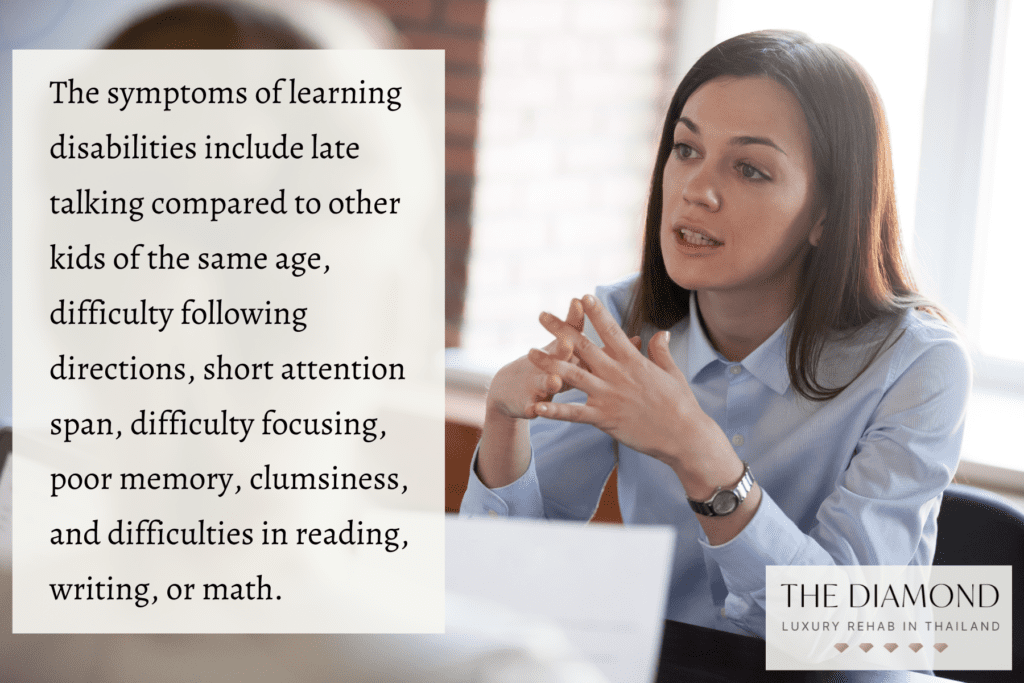
Next in the neurodevelopmental disorders list are learning disorders. Learning disorders are a group of neurologically-based disorders in which one or more learning areas are affected.
The symptoms of learning disabilities include late talking compared to other kids of the same age, difficulty following directions, short attention span, difficulty focusing, poor memory, clumsiness, and difficulties in reading, writing, or math.
Unlike with intellectual disabilities, learning disorders do not affect a child’s intellectual capabilities or general functioning and only affects how they process information in specific academic areas.
The physical effects of learning disorders include problems with movement and coordination, difficulty doing up buttons or shoelaces, trouble running or jumping, clumsiness, and poor hand-eye coordination.
Learning disorders also have behavioral effects, such as mood swings, poor organizational skills, temper tantrums, negative self-image, low self-esteem, defiance, and impulsivity.
8. Neurodevelopmental motor disorders
Neurodevelopmental motor disorders refer to the dysfunctions of the nervous system that cause abnormal, increased, or involuntary movements of the body. These conditions may also result in the absence of movements or repetitive extra movements.
The symptoms of motor disorders include tremors, gait problems, slow movement, difficulty swallowing and speaking, balance problems, twitches, jerks, spasms, stiff or inflexible muscles, and inability to move.
While cerebral palsy particularly refers to a condition brought on by injury to the developing brain, neurodevelopmental motor disorders are characterized by tics, or uncontrollable movements and speech. Both verbal and physical tics may be present.
The physical effects of movement disorders include difficulty walking, muscle weakness, problems with coordinating movements, muscle spasms, instability, clumsiness, and frequent falls.
These conditions can also have behavioral effects, such as loss of interest or initiative, anxiety, personality changes, agitation, delusions, hallucinations, and impulsivity.
9. Schizophrenia

Schizophrenia is a severe mental health condition that negatively affects how a person perceives reality. It interferes with an individual’s ability to think rationally, communicate emotions, and engage in decision-making.
The symptoms of schizophrenia include delusions, hallucinations, disorganized thinking and speech, inappropriate motor behavior, sleep problems, inability to experience pleasure, and lack of motivation.
Compared to other examples of neurodevelopmental disorders mentioned in this list, schizophrenia was the only condition first classified as a neurodegenerative disorder, until newer imaging studies in 1983 confirmed that schizophrenia has neurodevelopmental origins, as stated in an article written by Bryan T. Woods, M.D., for The American Journal of Psychiatry.
Furthermore, according to an article entitled, “Physical Health and Schizophrenia,” published in Living With Schizophrenia, the physical effects associated with schizophrenia are obesity, heart disease, stroke, diabetes, osteoporosis, and infectious diseases.
The behavioral effects of schizophrenia include poor personal hygiene, trouble focusing, speech disturbances, memory impairment, social isolation, lack of outward expression of emotion, and violent behaviors.
10. Tourette syndrome
Tourette syndrome (TS) is a neurological disorder that causes sudden, repetitive, and involuntary vocalizations and movements called tics. For instance, an individual with Tourette’s may keep on blinking, twitching their head, biting their lip, or yelling out a sound or phrase, which can sometimes be obscene.
The symptoms of Tourette syndrome include facial grimacing, shoulder jerking, sniffing, repeating others’ words or phrases, grunting, throat clearing, and sniffing.
According to a study on Tourette syndrome and comorbid neurodevelopmental disorders along the impulsivity-compulsivity spectrum published in September 2021 issue of Biological Psychiatry, along the impulsivity-compulsivity spectrum, Tourette syndrome (TS) is frequently observed co-occurring with other neurodevelopmental disorders, with attention-deficit/hyperactivity disorder (ADHD) being one of the most common.
The physical effects of TS include involuntary movements in the head and neck, and common side effects from Tourette medications, such as tiredness, stiff muscles, and weight gain.
The behavioral effects of Tourette syndrome are difficulties with turn taking, emotional dysregulation, inability to compromise, poor inhibition, explosive anger, inappropriate comments, excessive silliness, and oppositional defiance.
What are the causes of neurodevelopmental disorder?
The causes of neurodevelopmental disorder include different contributing factors that play a role in its development. The causes of neurodevelopmental disorder are listed below.
- Stress
- Illness
- Trauma
- Toxic chemicals in the environment
- Low birth weight
- Fetal exposure to smoking, alcohol, recreational drugs, or medications during pregnancy
1. Stress
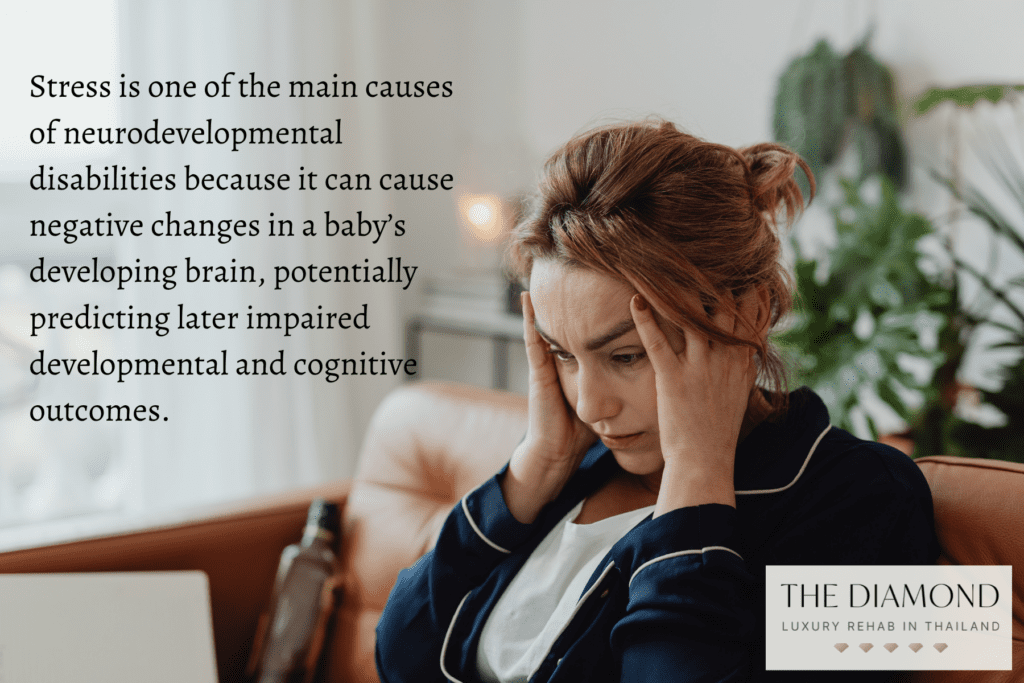
Stress is defined as the body’s natural reaction to an overwhelming event or situation that one feels as unmanageable. Even though it is normal to feel stressed when coping with the everyday pressures of life, excessive stress that is left unchecked can be the cause of more serious conditions, such as neurodevelopmental disorders.
According to an editorial article by P Pervanidou et al. on stress and neurodevelopment published in Frontiers in Neuroscience in April 2022, prenatal stress can have adverse and persistent effects on the different regions of the brain during its development, which may contribute to later neurodevelopmental symptoms and disorders.
Stress is one of the main causes of neurodevelopmental disabilities because it can cause negative changes in a baby’s developing brain, potentially predicting later impaired developmental and cognitive outcomes.
2. Illness
Illness refers to a state of poor health that can affect one’s body or mind. It occurs when there is a significant disturbance in an individual’s physical, emotional, or mental state that prevents their body or mind from functioning normally.
Illnesses or infectious disease acquired during pregnancy can have neurodevelopmental consequences to a developing child by being transmitted congenitally. For instance, infections, such as the human immunodeficiency virus (HIV), meningitis, and encephalitis can result in adverse neurological outcomes.
Illnesses can become a source of neurodevelopmental disorders because their symptoms can be unpleasant, and may expose the unborn child to an adverse intrauterine environment.
3. Trauma
Trauma is an emotional response that can have lasting effects even long after the intensely distressing life situation or event has been experienced or witnessed. Examples of incidents that can cause trauma include sexual violence, childhood abuse or neglect, accident, natural disaster, war abuse, or serious injury.
According to a study on the intergenerational effect of maternal exposure to childhood maltreatment on newborn brain anatomy published in Biological Psychiatry in January 2018, a mother’s exposure to early childhood trauma can negatively impact her newborn’s neurodevelopment by causing alterations in the child’s brain structure and function.
Trauma becomes a source of neurodevelopmental disabilities because a mother’s emotional state while pregnant may have adverse effects on the developing fetus.
4. Toxic chemicals in the environment

Toxic chemicals in the environment are harmful substances present in the environment that can negatively impact human health. Some examples are lead, arsenic, asbestos, cadmium, and mercury.
These environmental toxicants can harm the developing architecture of the brain by causing unwanted lasting or permanent changes to its form and function, as stated by K. D. Rock and H.B. Patisaul in 2018 study on the environmental mechanisms of neurodevelopmental toxicity published in Current Environmental Health Reports.
Chemical exposure during pregnancy is one factor that influences the development of neurodevelopmental disorders because harmful environmental toxins can alter gene expression.
5. Low birth weight
Low birth weight (LBW) is a term for newborns who weigh no more than 5.5 pounds (2500 grams), according to the National Cancer Institute. When a baby is born too soon (prematurely), a low birth weight may result.
A 2015 study entitled thalamocortical connectivity predicts cognition in children born preterm published in Cerebral Cortex journal asserts that preterm births can lead to long-term problems by causing neurodevelopmental alterations in brain connectivity and network architecture, which can result in impaired neurocognitive function that can persist into adulthood.
Being born with a low birth weight can cause neurodevelopmental problems because an immature nervous system can leave the brain more vulnerable to injuries and abnormal development.
6. Fetal exposure to smoking, alcohol, recreational drugs, or medications during pregnancy

Substance use during pregnancy refers to the intake of alcohol, nicotine, illicit drugs, and misuse of prescription medications while pregnant. Exposure to these unhealthy substances can cause a wide array of health problems to an unborn child.
For instance, drinking alcohol can disrupt the baby’s development by passing through the placenta and affecting the mental and physical growth of the child, while smoking can expose the unborn baby to nicotine, which can cause tissue damage in the lung and brain.
Recreational drugs can also cross the placenta and increase the risk of stillbirth and miscarriage. Newborns exposed to illegal drugs in pregnancy may also suffer from withdrawal symptoms, such as trouble sleeping, difficulty feeding, and jitteriness.
On the other hand, certain medications may be unsafe to take during pregnancy, including painkillers and others that treat chronic conditions. Children who were prenatally exposed to these medications may be at an increased risk for neurodevelopmental disorders.
Unhealthy habits such as drinking alcohol, smoking, and doing drugs can harm an unborn child because they receive much of what their mother eats, drinks, and breathes.
What are the symptoms of neurodevelopmental disorders?
Neurodevelopmental disorder symptoms often begin to show during a child’s preschool years. The most common symptoms of neurodevelopmental disorders are listed below.
- Problems with language and speech
- Impaired motor skills
- Abnormal behaviors
- Difficulties with learning
- Speech problems
- Social skills deficits
- Poor emotional regulation
1. Problems with language and speech
Problems with language and speech are impairments that interfere with the acquisition, comprehension, and use of language. These problems tend to persist into adulthood and negatively affect one’s academic, social, and behavioral functioning.
These difficulties occur as symptoms of neurodevelopmental disabilities due to damage in the area of the brain associated with language processing and understanding.
Language and speech impairments are considered as one of the symptoms of NDs because those with the condition have difficulty organizing their thoughts or have trouble coordinating the muscles around their mouth, resulting in a wide array of problems related to language and speech.
Problems in these areas can be identified by observing common signs, such as repetition of sounds or words, frequent pauses during a sentence, slurred speech, difficulty understanding what others say, overusing fillers in sentences, and trouble learning new words.
2. Impaired motor skills

Motor skills refer to the movement and coordination of the muscles that are crucial in performing everyday tasks. These skills help us execute daily functions, such as walking, talking, lifting, writing, or running.
Motor coordination impairments become a symptom of many types of neurodevelopmental disorders when children diagnosed with the conditions consistently display varying degrees of difficulty with both gross and fine motor skills.
Movement difficulties are also recognized as one of the signs of NDs because they are persistent and prevalent in many children diagnosed with those conditions due to certain differences in how their brains are wired and deficiencies in brain functions.
Deficits in motor skills can be identified early in children when they seem to be lagging behind peers of similar age when it comes to performing age-appropriate activities, such as catching or throwing a ball, using a spoon or fork to eat, buttoning buttons, or holding a pencil.
3. Abnormal behaviors
Abnormal behaviors are defined as atypical or statistically unusual behaviors that can be harmful to a person or those close to them. According to the American Psychological Association, abnormal behaviors are often indicators of a mental or emotional disturbance.
Behavior problems become an indicator of NDs when they are disruptive and challenging enough to affect a child’s daily life and the people around them.
These negative interactions are considered as one of the symptoms of neurodevelopmental disorders because they are consequences of poor self-regulation, which is very common in children diagnosed with NDs.
Behavior challenges can be identified in children suffering from NDs by looking out for warning signs, such as drastic changes in behavior, frequent tantrums and outbursts, threatening to hurt themselves, other people, or pets, and constant opposition to authority figures.
4. Difficulties with learning

Difficulties with learning refer to problems that affect areas of learning, such as reading, writing, math, or spelling. These difficulties can also interfere with more difficult skills, including organization, abstract reasoning, and short- and long-term memory.
Learning difficulties indicate the existence of a neurodevelopmental disorder if they impact a child’s life beyond academics and end up affecting relationships with their family and friends.
Problems with areas of learning are recognized as one of the symptoms of NDs because the learning process of children with these conditions are also affected in ways that can cause problems for them in school.
Academic struggles can be identified in children with NDs by watching for common signs, such as difficulty following directions, poor memory, daydreaming, excessive absences, difficulty reading, writing, or doing math, and working at a slow pace.
5. Speech problems
Speech problems are difficulties creating or producing the speech sounds necessary to communicate with others. The communication skills of many children with neurodevelopmental disorders are significantly affected.
Difficulties with speech become a symptom of many NDs because these challenges are noticeable early in a child’s life, especially when communication problems make it harder for them to understand social cues and interpret vocal tones.
Abnormal speech patterns are regarded as one of the many symptoms of NDs because these deficits are often observed in children with the conditions, due to various reasons, including difficulty developing communication skills, slow processing of language, or the area of their brain that controls speech has been affected.
Speech problems can be identified as a neurodevelopmental disorder symptom by looking out for key signs, including problems listening to spoken language, difficulty paying attention, repetition of sounds or words, pausing a lot while talking, and an inconsistent voice quality.
6. Social skills deficits
Social skills deficits are defined as irregular social approaches and the lack of desire to engage in meaningful conversations with others. Kids with neurodevelopmental disorders typically exhibit these challenges.
Impairment in social functioning becomes a symptom in many children with NDs because it is often a result of other difficulties they are already struggling with, including picking up on social cues, difficulty controlling emotions, interrupting conversations, or appearing disinterested during conversations. All of these can make them seem rude without meaning to, and lead to other peers avoiding them.
Social skills deficits are considered as indicators of neurodevelopmental disorders because they are a common denominator among the different types of those conditions.
One can spot problems with socializing by watching out for common signs, such as difficulty initiating conversations, reduced interest in peers, reduced object sharing, poor eye contact, and social avoidance.
7. Poor emotional regulation
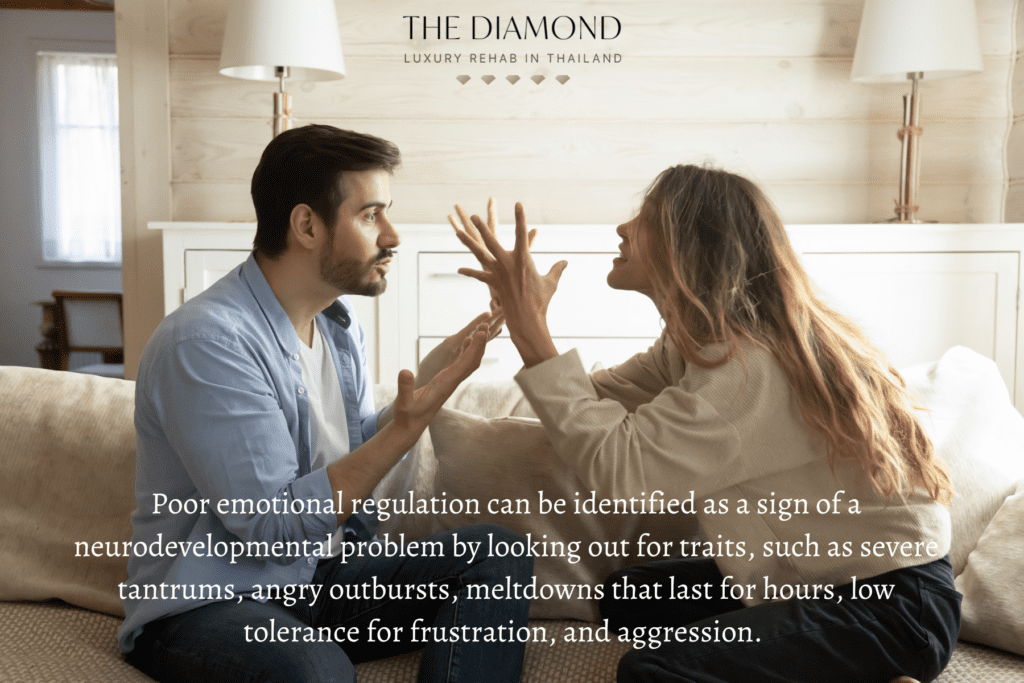
Poor emotional regulation refers to a person’s incapacity to regulate or control their emotional reactions to provoking circumstances, according to an article entitled, “Emotional Dysregulation” published in Psychological Care and Healing Center.
Emotional dysregulation has long been recognized as a symptom of neurodevelopmental disorders, because it is common in individuals diagnosed with those conditions.
Difficulty controlling emotions is indicative of a neurodevelopmental disability because it is a prominent feature among the different types of NDs. The poor executive function control that those with the conditions usually have also contributes to emotional trigger sensitivity and emotional impulsivity.
Poor emotional regulation can be identified as a sign of a neurodevelopmental problem by looking out for traits, such as severe tantrums, angry outbursts, meltdowns that last for hours, low tolerance for frustration, and aggression.
How is neurodevelopmental disorder diagnosed in children?
A neurodevelopmental disorder is diagnosed in children with the help of various tests, such as developmental tests, neurologic examination, brain imaging, laboratory tests, and physical examination.
These test findings will aid you in understanding how your child’s sickness has impacted his or her health and which treatment options are likely to be effective. The results will also help determine the course or expected development of the condition, which will help in formulating a treatment plan that is tailored to the specific needs of your child.
The medical team that will be involved in the neurodevelopmental evaluation of your kid may include a neurodevelopmental pediatrician, neurologist, ophthalmologist, or eye doctor, audiologist, a physical therapist, and a nurse practitioner.
How is neurodevelopmental disorder diagnosed in teens?
A neurodevelopmental disorder is diagnosed in teens by assessing the occurrence of unusual behaviors or delays in reaching developmental milestones and contrasting such behaviors with those of teenagers their own age, sex, and culture.
These can be done with the help of comprehensive psychological assessments, such as intellectual, neuropsychological, adaptive behavior, and psychiatric comorbidities assessments.
How is neurodevelopmental disorder diagnosed in adults?
A neurodevelopmental disorder is diagnosed in adults by assessing emotional-behavioral problems as part of the exam interview, and conducting brain imaging tests, such as magnetic resonance imaging (MRI) or electroencephalogram (EEG), as well as blood testing for seizure medicine.
In some cases, genetic testing may be done after a consultation with a certified medical genetics counselor.
The goals of these tests include confirming a neurodevelopmental condition diagnosis, defining structural abnormalities in the brain that could be contributing to neurobehavioral problems, identify genetic origins of the disorder, and assist in making referrals for psychiatric services.
Who is at risk for neurodevelopmental disorders?
Children with a history of preterm birth and low birth body weight are the most at risk for neurodevelopmental disorders, according to a systematic review and meta-analysis on the risk of neurodevelopmental disorders in children born from different assisted reproductive technology (ART) treatments published in December 2020 in the Journal of Neurodevelopmental Disorders.
Study authors Tono Djuwantono, Jenifer Kiem Aviani, Wiryawan Permadi, Tri Hanggono Achmad, and Danny Halim also assert that cerebral palsy, intellectual disability, and autistic disorders are the NDs mentioned in which increased risk is noted with preterm birth history or history of low birth body weight.
What are the available treatments for neurodevelopmental disorders?
Treatment options available for NDs mainly help manage their symptoms. The available treatments for neurodevelopmental disorders are listed below.
- Behavioral therapy
- Transcranial magnetic stimulation
- Medication
- Complementary and alternative medicine (CAM)
1. Behavioral therapy
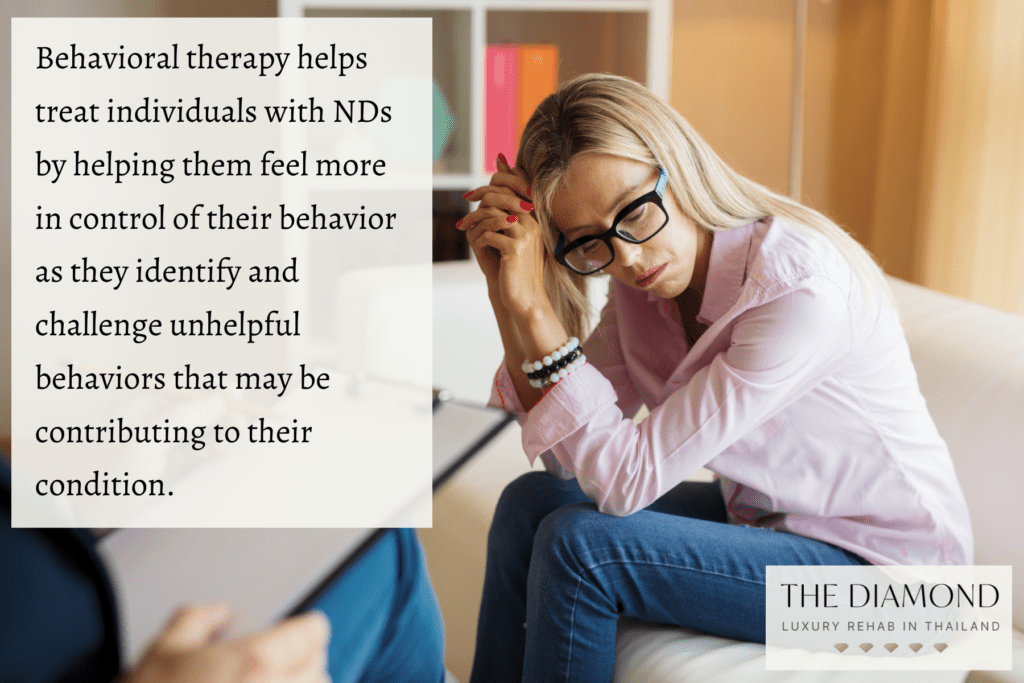
Behavioral therapy is a term used to describe a wide array of psychological approaches aimed at shifting self-defeating behaviors. Forms of behavioral therapy commonly used for neurodevelopmental disorders include cognitive behavioral therapy (CBT), applied behavior analysis (ABA), psychotherapy, speech therapy, and developmental therapy.
Behavioral therapy helps treat individuals with NDs by helping them feel more in control of their behavior as they identify and challenge unhelpful behaviors that may be contributing to their condition.
It is one of the treatments for many neurodevelopmental disabilities because behavioral therapy is focused on patterns of behavior and how these patterns influence one’s actions, thoughts, and moods.
Behavioral therapy is extremely effective for the treatment of a range of mental health conditions. In fact, an article entitled, “Understanding Psychotherapy and how it works,” from the American Psychological Association states that psychotherapy is beneficial for 75% of people who undergo the treatment.
The length of therapy may vary depending on the condition and treatment type to be used by your therapist, but on average, behavioral therapy typically lasts between 6 and 20 sessions before the majority of patients start feeling better.
2. Transcranial magnetic stimulation
Transcranial magnetic stimulation (TMS) is a non-invasive treatment procedure that uses a changing magnetic field to stimulate nerve cells and influence brain activity. It is approved by the U.S. Food and Drug Administration (FDA) for depression and obsessive-compulsive disorder (OCD), but research continues to find other potential uses for TMS.
It helps treat some neurodevelopmental disorders by sending magnetic waves to a specific part of the brain that needs additional stimulation. Many of these conditions are caused by reduced amounts of neurotransmitters or excessive neural activity in the brain.
TMS is one of the treatments for certain NDs because electrical charges enable brain activity, and this method impacts electrical activity in the brain without the use of painful electric current.
TMS can be safely used by patients with neurodevelopmental disorders, and it has shown promising benefits in such cases. However, its use for a wide range of disorders is still in its infancy and more research is needed to prove other potential uses it may have.
The first cycle of TMS usually lasts for four to six weeks, with sessions done five days a week, and with each session lasting for about 15 to 45 minutes. After the first cycle, there will be a continuation phase, where the number of sessions are reduced to two days a week for eight to 12 weeks.
3. Medication
A medication refers to a prescription drug used to cure, treat, or prevent a disease. In the case of neurodevelopmental disorders, medications prescribed may include stimulants, antidepressants, anticonvulsants, antipsychotics, or adrenergic agonists.
These medications help treat NDs by mainly helping with managing or coping with symptoms, and they are part of the treatment for such conditions because since they have no cure, just treating the symptoms that can interfere with the daily lives of those with NDs may significantly improve their functioning.
Symptomatic drug treatment is effective for individuals affected by NDs, as it helps them improve their daily living skills and increase their lifespan. The duration of pharmacological treatment may vary depending on the type of disorder, but for lifelong conditions such as NDs, medications may be taken for months up to years.
4. Complementary and alternative medicine (CAM)
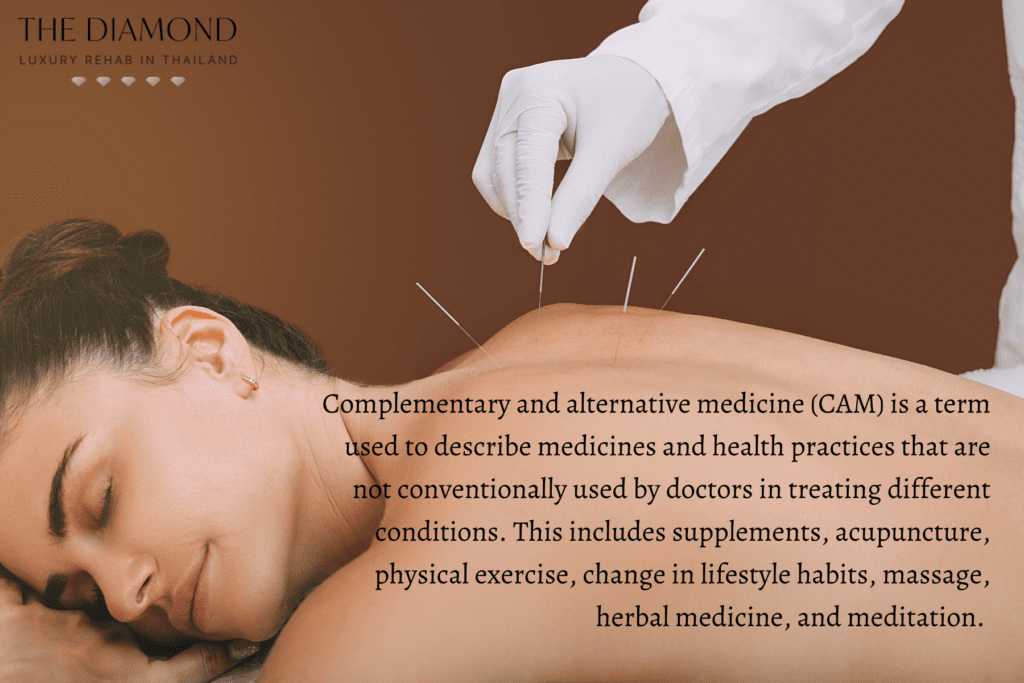
Complementary and alternative medicine (CAM) is a term used to describe medicines and health practices that are not conventionally used by doctors in treating different conditions. This includes supplements, acupuncture, physical exercise, change in lifestyle habits, massage, herbal medicine, and meditation.
CAM may help treat individuals with NDs by allowing them to create healthier lifestyle habits in which they can engage in along with other forms of treatment. It is also considered as one of the treatments for neurodevelopmental disabilities because some patients prefer not to have the side effects of conventional medical treatments.
There is still a lack of data regarding the effectiveness of CAM practices, but it is becoming an increasingly popular treatment option, especially for those with autism spectrum disorder (ASD).
There is no definitive duration for complementary and alternative medicines, and how long one engages into these practices may vary greatly. However, attending mindfulness meditation sessions usually take eight weeks.
What are the early preventions for neurodevelopmental disorder?
There are no early preventions for most neurodevelopmental disorders. However, for these conditions associated with genetics and the environment, proper prenatal care increases the likelihood of having a healthy, full-term baby with a lower risk of neurological issues.
Committing to healthy choices while pregnant and establishing healthy habits prior to getting pregnant can increase your chances of providing a healthy start for your child and help you feel more at ease.
Are neurodevelopmental disorders permanent?
Yes, neurodevelopmental disorders are permanent and there is no known cure for these conditions as of writing. However, there are therapeutic strategies available that can help those with NDs manage and cope with their symptoms.
Furthermore, as with many other conditions, early identification and intervention are essential to improving a child’s quality of life who exhibits neurodevelopmental delay-related signs and symptoms.

